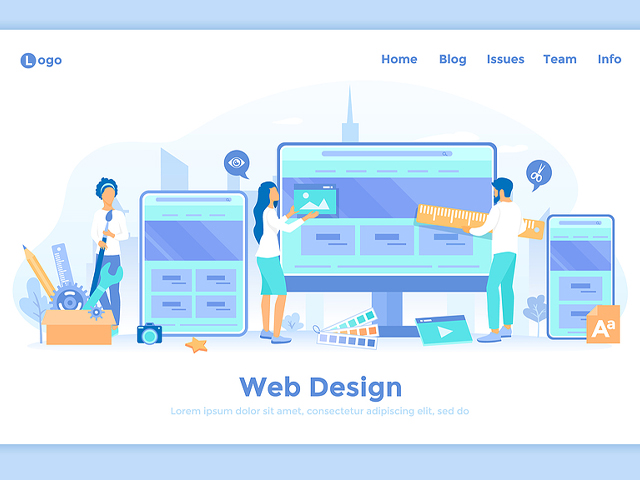
There is a variety of ways you can become a UI Designer. There are numerous fields you can enter this discipline from including psychology, coding and design, these careers all offer various strengths that can be used to influence a UI Designer path.
Get Familiar with Key Design Principles
There are basic fundamentals that Visual Designers rely on to use texture, shape, lines, colors, layout, type and images to present a specific layout of organized information. These efforts engage users intellectually and visually to evoke feelings and direct their eyes. Surround yourself in design and study what is popular and what isn't. Break down what is working and what isn't. Design is not a science, it is an art. Therefore, there are no correct answers and expanding your design knowledge is a never-ending task.
Understand Essential UI Design Tools
Eventually, you will want to take a UI design course that includes the tools you will be working with including wireframing applications including Illustrator, Figma, Sketch, InVision Studio, Marvel, and Adobe XD. You will practice imaging programs such as Photoshop, and prototyping programs including ProtoPie, Flinto, Principle, Flinto and Proto.io. It won't be necessary to learn all these programs since many of the processes are transferable between platforms. However, it is recommended that you are familiar with the popular applications in every category.
Enlist In A UI Design Course
UI covers design fundamentals and other specialized skills including alignment, repetition, gestalt principles, contrast and how to create balance. These strategies are used to deliver information to the user and to create a visual that is pleasing to the viewer. You will need to understand how to develop a design concept using personas and the details of user testing, prototyping, and wireframing.
A reputable UI design class will go over the fundamental principles of UI design and teach the required skills that every UI Designer should possess. UI design classes are the perfect way to familiarize yourself with the digital tools that UI Designers often rely on to complete their work.
What is the Best Way to Begin my Career in UI Design?
Start out by getting familiar with all the design subfields if you want to pursue a career in UI design. This will help build your confidence that UI design is truly the path you want to take.
Next, research what UI designers do every day by speaking with those who work in the field to discover the types of jobs you will be involved with. This is a great way to obtain helpful advice and discover the basic principles that drive UI design.
After you are confident that a UI Design career is right for you, it is time to start creating your skills. Taking a bootcamp course or other classes geared to UI design is the best way to accomplish this. You will be confident that your training will cover all the vital topics and you can avoid wasting time in less useful ways.
Enjoy being part of a structured learning environment to receive constant feedback during your training. You will even gain some career guidance when you are ready to start searching for work.
Putting your skills to the test is the next step. Create your own practice projects to earn a chance to expand, explore and streamline your UI design abilities. This also gives you the chance to create work for your professional portfolio.
With your resume, your portfolio is your most essential tool to showcase your skills and help you connect with possible employers. Use a platform like GitHub to share your work and present your talents. Use an easy-to-read method and outline your steps to establish objectives. Define any obstacles you faced and outline how you came up with innovative solutions to solve these issues.
Remember, design is a lifelong adventure, similar to all creative arts. There are continually new things to discover and innovations to explore. Technology is also evolving continually. There are multiple UI Designer tools that are available and constantly expanding. You can enjoy continuous learning throughout your career and will never grow bored. The excitement of taking on new possibilities and exciting endeavors never fails for a UI Designer.
Create your own projects to Enhance your UI Design Abilities
Practice your freshly acquired digital skills by working on your personal UI projects. Practice the various stages of UI design and create portfolio pieces. After you are familiar with prototyping, wireframing and imaging programs, you will be ready to start creating projects that utilize your skills.
Develop original projects that allow you to hone your UI skills at various stages instead of simply recreating design elements. Start with testing models and research.
Next, create the user personas that will transform your design as you navigate the design phases. Conceive ideas and create interactive design elements including buttons, menus, page navigation and search fields. Experiment with color palettes, interactive media and new layout options.
Make use of your design knowledge foundation with color theory, typography and branding to show your skills in each area of expertise.
Once you reach the prototyping and wireframing stages, try to incorporate other interactive design principles to challenge yourself. Create innovative ways for users to interact and navigate with the content on your app or site.
Always be on the lookout for opportunities to strengthen your soft skills along the way. Partnering with other people will bring you team experience and grow your communication skills. This is an ideal asset for anyone, especially a UI Designer.
When presenting projects to obtain feedback from others, note how easy they are to interact with and if they are intuitive enough. This will contribute to your user empathy development which is another essential skill to have in this career.
Show Off your UI Design Work by Developing A Portfolio
Think of your portfolio as your most vital marketing tool. Make it as creative and unique as you are. Start with an idea for some project that interests you.
Next, chart your progress along the way from beginning to end. Highlight the creative solutions you relied on at every turn to create your end result. Lastly, share your project on GitHub or another public platform to start growing your network and gain attention.
When seeking jobs, tailor your portfolio items to indicate you are a fit for the company you are applying to. Show them the kinds of projects you will be undertaking. Your project choice needs to highlight the strengths you will be drawing on in your new position.











